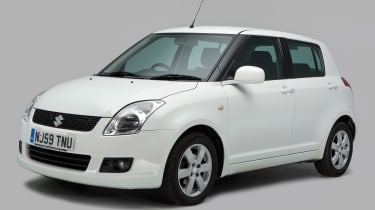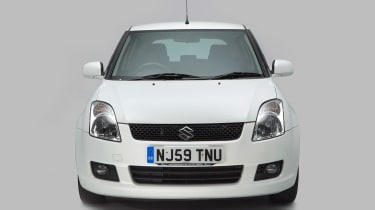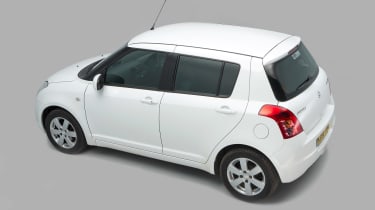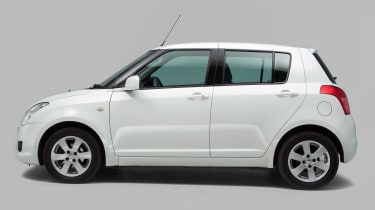Used Suzuki Swift review
A full used buyer’s guide on the Suzuki Swift covering the Swift Mk5 (2005-2010) and the Swift Mk6 (2010-date)
Suzuki Swift didn’t make much of an impact. But by 2005, when the brand unveiled the fifth-generation version, it had really nailed it. When we tested one of the first cars, we said: “The new Swift has wide appeal.
Buyers in this class will be attracted to the car’s easy-to-drive characteristics, roomy accommodation for four and excellent value for money.
“High spec levels and decent build are strong points, too. Suzuki’s latest offering is a far cry from the lacklustre car it replaces.” Now, used buyers can get the benefit, as the Swift is available at bargain prices.
Suzuki Swift Mk5
Prices from £2,000
History
The fifth-generation Swift hatchback debuted a decade ago, with 1.3 or 1.5-litre petrol engines, both featuring manual gearboxes, and a choice of three or five doors. There was an automatic transmission option, but only with the 1.5.
From January 2006, Suzuki offered a turbodiesel, badged 1.3 DDiS and using a Fiat sourced engine. This was only available in five-door Swifts.
A new flagship 125bhp 1.6-litre Swift Sport joined the range in September that year, and this came solely in three door form. In January 2010, the GL and GLX trims offered from launch were replaced by SZ2, SZ3 and SZ4. However, just eight months later, an all-new Mk6 Swift reached showrooms.
Suzuki Swift Mk5 reviews
Suzuki Swift in-depth reviewSuzuki Swift 2005 reviewSuzuki Swift Sport 2006 reviewSuzuki Swift Sport reviewSuzuki Swift Sport long-term test review
Which one should I buy?
The 1.3-litre engine is sweet, yet struggles on the motorway; for long-distance drives, you’re better off with a 1.5-litre car. The diesel is muscular, efficient and surprisingly refined, but rare, while the Sport is a riot to drive and highly recommended.
Suzuki offered the Swift 1.3 in GL trim only, and it featured remote central locking, electric front windows, electrically adjustable, heated door mirrors, a six-speaker CD/tuner, Isofix plus side and curtain airbags.
Used - available now

2019 Suzuki
Swift
16,006 milesManualPetrol1.0L
Cash £10,400
2021 Suzuki
Swift
12,364 milesAutomaticPetrol1.2L
Cash £14,499
2019 Suzuki
Swift
13,865 milesManualPetrol1.2L
Cash £11,695
2019 Suzuki
Swift
31,570 milesManualPetrol1.2L
Cash £8,287The 1.5 was available solely in GLX spec, and added alloy wheels, air-con and keyless entry. The diesel got GLX levels of equipment, but with traction control added to the mix.
Alternatives to the Suzuki Swift Mk5
If reliability is key, the Toyota Yaris is for you, although prices are relatively high and kit looks miserly compared with the Swift. The SEAT Ibiza is good to drive, well equipped and stylish, while second-hand values are low, build quality is good and there are some excellent engines on offer.
If value is important, you should give the Fiat Punto or Renault Clio some serious consideration; not only are they cheap to buy, they’re well equipped and good to drive, although reliability generally isn’t up to Suzuki levels.
Don’t overlook the very desirable Ford Fiesta, either; it’s in plentiful supply, great fun on the road and practical, while it looks smart, too.
What to look for:
Cabin rattles
All sorts of squeaks, creaks and rattles can emanate from inside the Swift. Many come from behind the dash, so they need major surgery to resolve.
Dampers
Dampers can be weak, so sharply push the car down at each corner and see if it quickly settles. If it doesn’t, the shock absorbers need replacing, in pairs.
Tyre wear
Watch for uneven tyre wear, as the wheel alignment is usually thrown out if the car has been jacked up by its suspension at the rear.
Gearbox
Listen out for a noisy gearbox on high mileage examples, as the bearings can fail. Once this happens, an expensive rebuild is the only solution.
Interior
There are some cheap plastics inside the Swift, but they don’t dominate and it’s better finished than you may expect. The seats wear well and it’s easy to get comfortable up front, but rear legroom is tight, as is boot space, at 213 litres, or 562 litres with the rear seats folded.
Running costs
All Swifts need maintenance every 9,000 miles or 12 months, with a minor service followed by a major one, then an intermediate check. These officially cost £132, £264 and £184 respectively, but Suzuki offers fixed-price maintenance (minor service £129; major service £259) for models over three years old, as all Mk5 Swifts now are. All engines are chain-driven, so replacement cambelts aren’t needed, but fresh brake fluid is required every 18,000 miles or two years, at £45.
The coolant should also be replaced every three years or 27,000 miles (at £70), while the air-con needs to be checked every other service – expect to pay around £49 to have the system regassed when this is necessary.
Recalls
The Swift has been recalled five times so far. The first was issued in January 2007 and affected cars built up to September 2005. Examples built up to May 2007 were called back in 2007, and then again in 2009 due to issues with the handbrake and seatbelts failing and the boot light catching fire. In 2008, Swifts produced prior to May that year were recalled because the passenger’s airbag could deploy for no reason.
Driver Power owner satisfaction
Considering the Mk5 Swift’s age, its failure to make the top 150 in our 2016 Driver Power customer satisfaction survey was no surprise.
Verdict
Suzuki didn’t exactly get carried away with the engine and trim options, but that doesn’t stop the Swift from being an enticing used car thanks to the value, style and performance on offer. There are plenty of cherished, low-mileage examples out there as the car is a popular private buy. We ran a Swift Sport for 12 months and loved most aspects of ownership, like the zesty handling, decent economy and surprisingly roomy boot. Refinement could be an issue on motorways and the car wasn’t 100 per cent reliable, but there was no denying the fun, at bargain prices.














